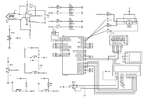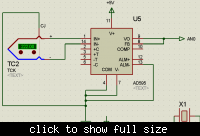Zwilorg
Member level 5
hello,
i am here to ask how can i get the thermocouple type K working with an AD623 opamp!
i have the program on the pic16f877 working without any problem i believe...
i used the Potenciometer (RV5) connected to AN0 for posterior conversion of data from analog to digital, just for testing...
i never thought i would have so much problems getting the data from the thermocouple....
Can someone check my circuit and see what is wrong in the build of the opamp?
Everything else is right and tested so just focus on the AD623 and the thermocouple
so just focus on the AD623 and the thermocouple
In this picture i used the REF on AD623 as +2.5V just to see what it would give as a result... i used ground also...
I also read that i could use max6675 more easilly than add623 but the maximum temperature it reaches is 1024C is this true?

i am here to ask how can i get the thermocouple type K working with an AD623 opamp!
i have the program on the pic16f877 working without any problem i believe...
i used the Potenciometer (RV5) connected to AN0 for posterior conversion of data from analog to digital, just for testing...
i never thought i would have so much problems getting the data from the thermocouple....
Can someone check my circuit and see what is wrong in the build of the opamp?
Everything else is right and tested
In this picture i used the REF on AD623 as +2.5V just to see what it would give as a result... i used ground also...
I also read that i could use max6675 more easilly than add623 but the maximum temperature it reaches is 1024C is this true?

PHP:
http://dl.dropbox.com/u/2769457/ad623.png
